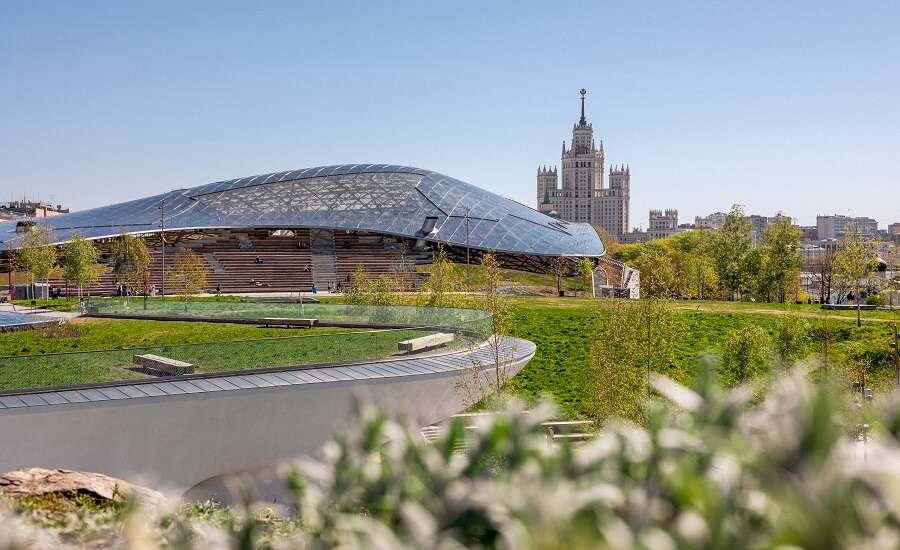
Photo from https://www.zaryadyepark.ru/
In the very heart of the Russian capital, a stone’s throw from the Kremlin and St Basil’s Cathedral, you’ll find the oasis of green space that is Park Zaryadye. One of the most ambitious architectural and landscaping projects in Moscow since the collapse of the USSR, Zaryadye is a place for education and recreation, with sections representing the diversity of Russia’s landscapes, events and exhibition spaces, and historical and architectural monuments.
The Zaraydye district is one of the oldest parts of Moscow and the oldest trading settlement outside of the Kremlin. From the 1200s to 1500s Zaryadye was inhabited by artisans of all trades and, later, by merchants, government officials, and nobles. After Peter the Great founded St Petersburg and built a rampart blocking Zaryadye’s sewage moat, the nobility departed for the new capital and Zaryadye became a dangerous, neglected, and polluted district.
Did you know? Master iconographer Simon Ushakov, whose work can be seen in Russia’s medieval churches and prestigious museums, lived in Zaryadye in the 17th century.
Despite efforts by Catherine the Great and Alexander I to improve the urban planning and infrastructure of the district, the thriving trade hub of Zaryadye remained a densely-populated slum with a reputation for drunks and brawls.
Did you know? A plague riot occurred in Zaryadye in 1771, after religious services were cancelled to slow the spread of infection. This was the last plague outbreak in the history of Europe.
With the total ban on private trade imposed in the USSR in 1931, Zaryadye’s businesses were forced to close and its residents dispersed. At the same time, architectural plans were being conceived to develop the new capital of the Soviet Union, and eyes turned to Zaryadye as an ideal site for experimental architecture and urban planning. Various high-profile projects were planned there from the 1920s to 1940s, such as the House of Textiles, Commissariat of Heavy Industry, and 2nd House of the Council of People's Commissars, though none were ever executed.
Zaryadye’s future was determined in 1947, when Stalin commissioned his Seven Sisters skyscrapers to demonstrate the victory and regeneration of the post-war Soviet Union. The tallest and most central of the Seven Sisters would be the Zaryadye Administrative Building, built by Dmitry Chechulin. In order to construct this vast monument of architecture and engineering, the Zaryadye district was demolished and nearly 8,000 residents were evicted. Luckily, some buildings of historic and architectural value were saved. Nevertheless, after endless architectural revisions and the death of Stalin, the plan was scrapped. A gigantic hotel – Hotel Rossiya – was erected on the site of the failed project in the 1960s (also led by Chechulin), and the remainder of Zaryadye was demolished during the construction process.
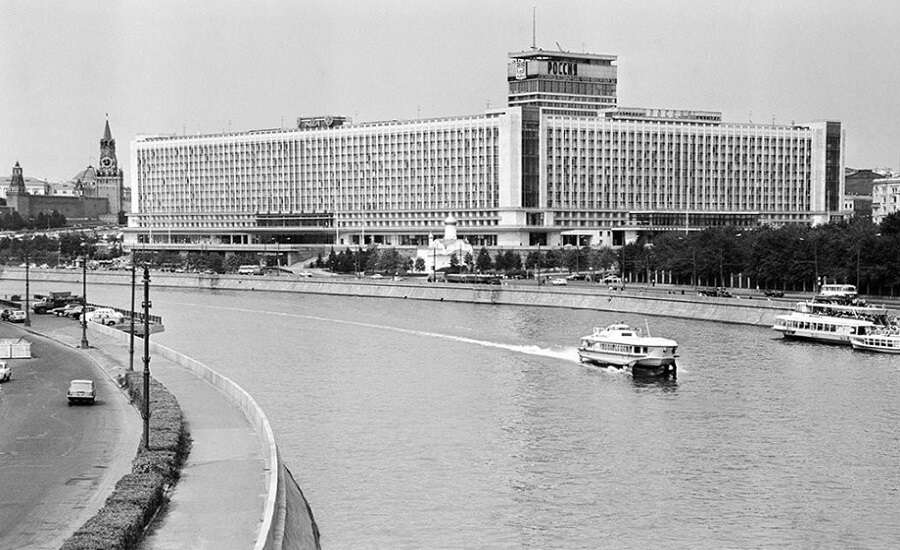
Photo from https://mf.bmstu.ru/
Did you know? At the time of opening, Hotel Rossiya was the largest hotel in the world, and could accommodate 5,890 people in its 3,182 rooms. It also had a 2,500-seat concert hall and a two-hall cinema with 1,536 seats.
The once-prestigious hotel, home to celebrities, foreign visitors, and international events, became outdated by the 1990s and was demolished in 2004. Plans for the site included a shopping centre, hotel complex, and parliamentary centre. Yet residents and experts alike opposed these plans to redevelop Zaryadye once again with fancy buildings or high-rises, and the idea occurred to create a public park in the very heart of Moscow. In January 2012, Vladimir Putin visited the site and recommended this course of action to Mayor of Moscow, Sergey Sobyanin.
After an international competition with 420 entries from 27 different countries, it was decided to design a park according to the concept of ‘wild urbanism’, which strives for a balance between urban development and the beauty of nature. Park Zaryadye was opened on 9th September 2017.
Did you know? As only six species comprise 99% of trees in Moscow, a rich variety of trees were planted in Park Zaryadye to enhance the unique landscape.
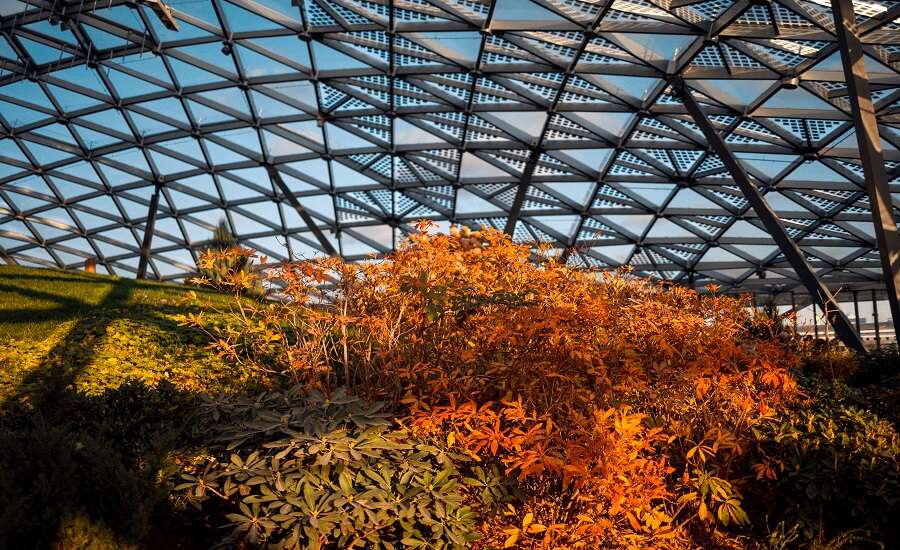
Photo from https://www.zaryadyepark.ru/
Zaryadye Park comprises several different landscape zones, bringing the diversity of Russia’s natural habitats to the urban sprawl of Moscow. More than one million plants make up these landscapes, which each have specially-engineered microclimates. On Park Zaryadye website you can explore the botanical collection and botanic calendar of which plants to look out for as the seasons change. The landscape zones are:
Northern landscapes: beautiful flora can grow even in the harsh Arctic landscapes of Russia. Here, you can see cedar, willow and dwarf trees, and hardy shrubs and grasses growing on rocky outcrops. Mist-forming machines recreate the humid marshy landscape of this permafrost zone.
Coniferous forest: the taiga of Russia, spanning from Europe to the Far East, is home to over half of the planet’s coniferous forests. Here are fir, spruce, and pine trees, and undergrowth of lily-of-the-valley, ferns, and primroses. It is important to stick to the paths in this zone, as the shallow roots of the spruce trees are damaged by trampling.
Mixed forest: this type of forest is found in the southern taiga and thrives in a climate of relatively cold, long winters and mild summers (the climate of Moscow and St Petersburg). Here, you can find oak and maple trees alongside spruce and pine trees, and flowers such as violet and forest geranium.
Coastal forest: this zone is located on the damp soil of the Moskva riverbank. It is populated by grasses and shrubs, flowers such as creeping buttercup, forest forget-me-not, and meadowsweet, and ancient trees which have been preserved from before the park was built. Insects and animals such as frogs, newts and waterfowl inhabit this zone.
Birch grove: birch is a hardy tree which can withstand harsher climates and territories, and is a symbol of Russia. As you stand in the birch grove you can admire a view of Red Square, St Basil’s Cathedral, and the Kremlin – you can’t really get more Russian than that!
Steppe: these plains cover swathes of southern Russia, from the Black Sea and Caucasus to the Transbaikal region. The hot, dry summers and snowy winters mean that the steppe is covered in drought- and frost-resistant grasses, including ornamental and flowering grasses which bring beautiful diversity to the landscape. Limestone was added to the soil to create the correct pH for this flora.
Meadow: a great variety of grasses and gorgeous wildflowers cover the meadow zone, ranging from 15cm tall to 2m tall! The meadow has been planted with exploration in mind, and visitors can relax amongst the nature here.
A scientific and research centre of genetics, biotechnology, microbiology, geography and ecology. It comprises a laboratory with educational programmes for adults and children, and halls for conferences, lectures and masterclasses. There is also a Florarium – a unique modern greenhouse designed by the Moscow Institute of Architecture and Art, home to 150 exotic species.
This huge glass canopy with solar panels covers a grassy hill dotted with flowers, which has its own regulated microclimate. Whilst the canopy protects visitors from the elements, the lack of exterior walls allows fresh air to breeze through. Underneath the canopy is the Large Amphitheatre, one of the largest open-air concert venues in Moscow which can accommodate 1,500 spectators. Opposite is a small amphitheatre seating 400. You can attend an event, or simply relax on the hill and admire a beautiful view over Moscow.
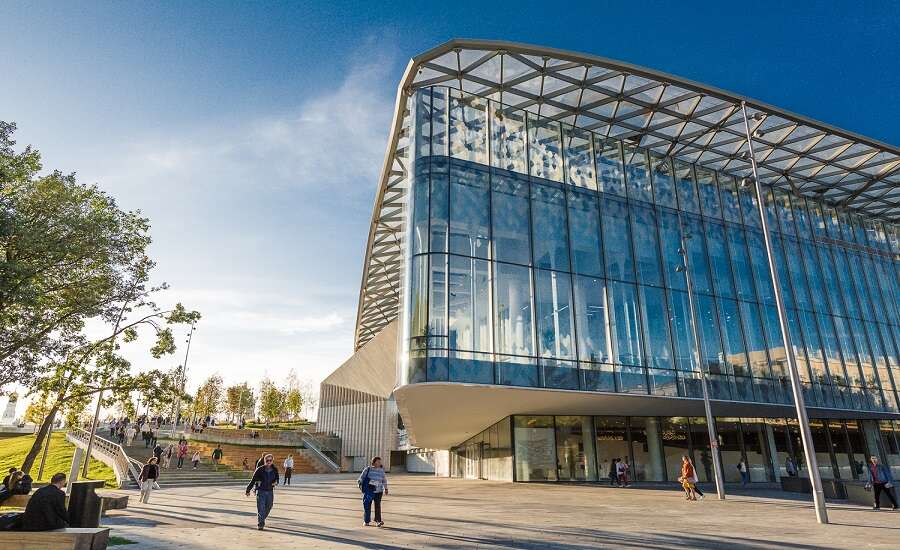
Photo from https://www.zaryadyepark.ru/
Adjoining the Glass Canopy are the Large and Small Concert Halls, seating 1,550 and 400 people. The 360-degree seating and the stage of the Large Hall are ‘dynamic’, and can be transformed to suit different events. This hall hosts various musical performances is home to one of the largest organs in Europe (containing 5,872 pipes!), installed at the beginning of 2020. The Small Hall hosts educational programmes, concerts, performances, and masterclasses. Events schedule is found here.
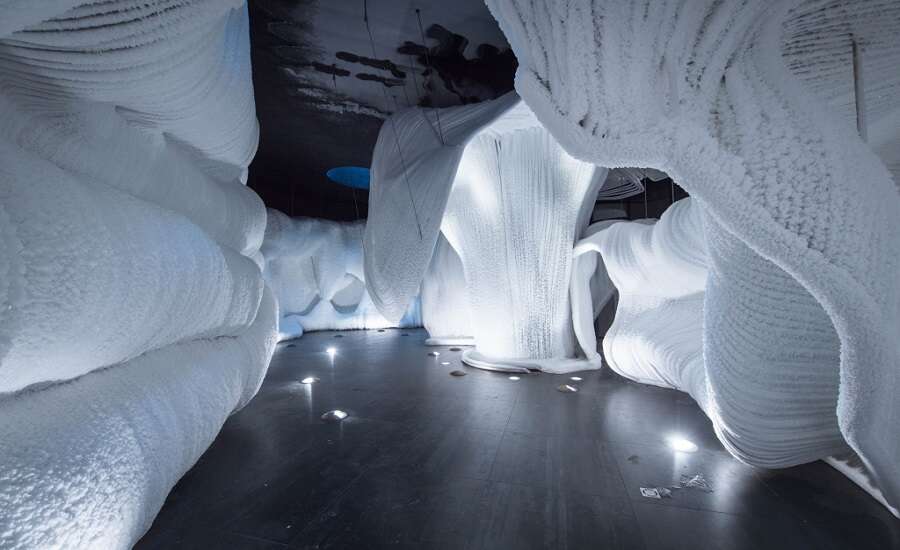
Photo from https://www.zaryadyepark.ru/
An art installation which transports the viewer into the frosty world of the north. To create the Ice Cave, artist Alexander Ponomarev and architect Alexey Kozyr froze 70 tons of water over 14 kilometres of metal pipes. The otherworldly cave is kept at temperature of -4 to -9 °C (you can purchase a blanket there for your visit).
An interactive museum built on the site of one of Moscow’s oldest streets, Velikaya Ulitsa. It is home to an art exhibition entitled #три_ (three), which is updated monthly to feature three works of art by three Russian or Soviet artists alongside their biography and historical context. The museum is built along the Kitai-Gorod Wall, Moscow’s medieval city wall, and there is also an exhibition here.
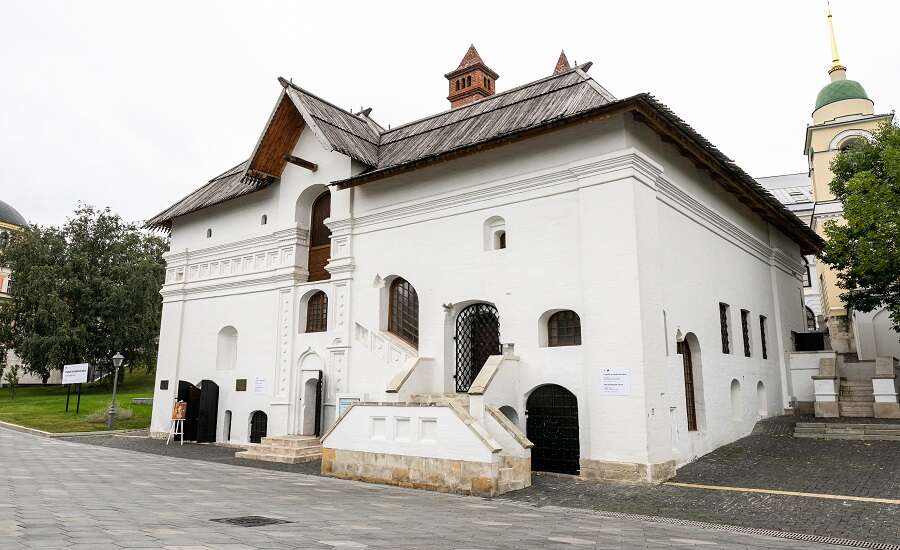
Photo from https://www.zaryadyepark.ru/
This building dating from the early 1500s is one of the only remaining monuments of medieval merchant life in the Zaryadye district. It housed the chambers of the Old English Court, gifted to the English merchants by Ivan the Terrible. The exhibition displays archaeological items discovered during the construction of the park, the life of an English merchant house in the 1500s and 1600s, and chronicles the Anglo-Russian relationship that began here and flourished under Ivan the Terrible and Elizaveta I. Queen Elizabeth II of the UK personally attended the opening of this museum in 1994, and the museum became part of Park Zaryadye in September 2020.
The Media Centre is home to two cinemas, a tourist information centre, exhibition spaces, souvenir shops and cafes.
360 Media Hall: the 5-metre, 360-degree screen in this 4D cinema takes you on a virtual tour of Russia’s nature and landscapes, and also shows a ‘Time Machine’ film chronicling the development of Moscow over the centuries.
Polyot (Flight) Media Complex: this 4D cinema hall shows the ‘Flight over Russia’ and ‘Flight over Moscow’ films, allowing you to explore the main attractions of Russia’s cities and landscapes from a bird’s eye view on a 13-metre hemispherical screen.
Exhibition hall: exhibitions devoted to Russia’s history, culture, and nature are held here in collaboration with leading museums and galleries.
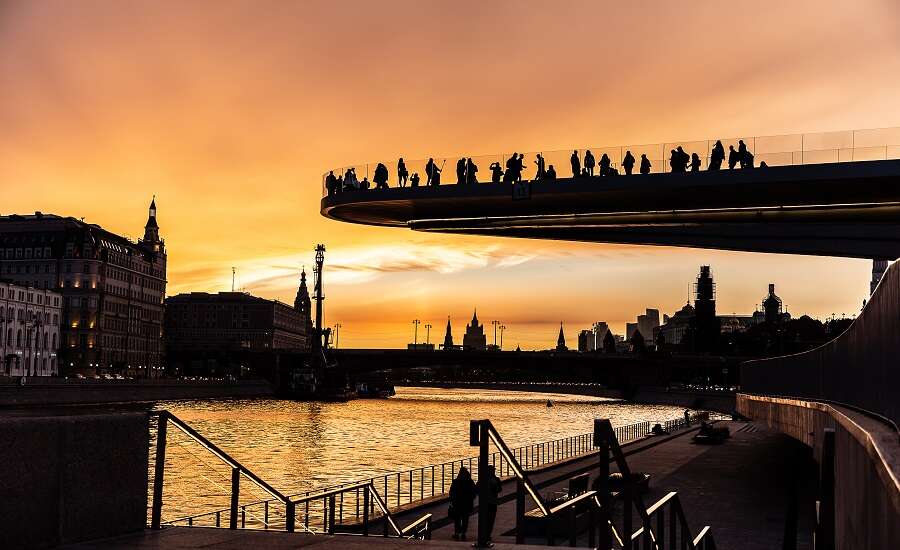
Photo from https://www.zaryadyepark.ru/
A 140-metre long viewpoint suspended over the Moskva River, providing a panoramic view of many of Moscow’s landmarks such as the Kremlin, St Basil’s Cathedral, and the Kotelnicheskaya Embankment Building.
Relax on the Nizhnaya Moskvoretskaya Embankment on the Moskva River, one of the capital’s oldest embankments. You can also take river taxis and boat trips from the pier here.
Three thematic walking routes have been designed in Park Zaryadye. ‘Russian Nature’ leads you around the landscape zones; ‘Heart of Moscow’ provides the best views of the capital’s historical and architectural landmarks; and ‘Engineering Miracle’ showcases the unique architecture of Park Zaryadye.
Ulitsa Varvarka: one of the oldest streets in Moscow, where you can find the historical monuments and churches of Zaryadye district which survived throughout the centuries.
Red Square: the central square of Moscow, bordered by the Kremlin, St Basil’s Cathedral, Lenin’s Mausoleum, and GUM Department Store.
Tretyakov Gallery: One of the world’s finest art museums, home to a millennia of Russian artwork.
Essential information for visitors
Address and contact details
Varvarka Ulitsa, Estate 6, Moscow, 109012
Website: https://www.zaryadyepark.ru/en/
Email: parkzaryadye@culture.mos.ru
Phone: +7 (495) 531-05-00
Nearest metro: Kitai-Gorod (200m from metro exit 14), Okhotny Ryad (740m via Red Square)
Opening hours and tickets
Zaryadye Park is open 24/7
The attractions have different opening times and prices, visit the website for more information
Join us on Facebook
We invite you to become a fan of our company on Facebook and read Russian news and travel stories. To become a fan, click here.
Join our own Russian Travel, Culture and Literature Club on Facebook. The club was created to be a place for everyone with an interest in Russia to get to know each other and share experiences, stories, pictures and advice. To join our club, please follow this link.